

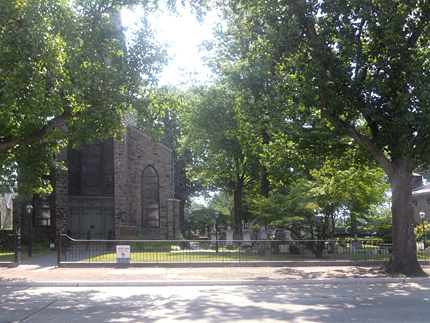
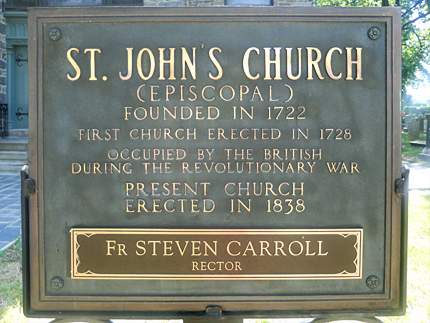
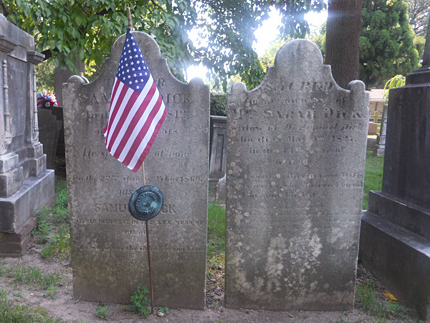
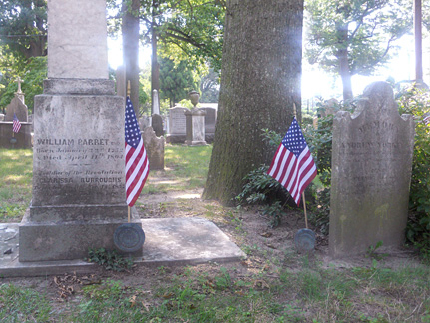
St. John's Episcopal Church
76 Market St.
Map / Directions to St. John's Episcopal Church
Map / Directions to all Revolutionary War Sites in the town of Salem
British Occupation of Salem - March 1778 [1]
St. John's Church was Damaged in the Occupation
In March 1778, Salem was occupied by about 1500 British and Loyalist troops under the command of Colonel Charles Mawhood. Loyalist troops were Americans who sided with and fought for the British in the Revolutionary War.
Mawhood's objective was to confiscate cattle, hay, and corn to bring across the Delaware River to Philadelphia, which was controlled by the British from September 26, 1777 until June 18, 1778.
Local citizens moved some of the cattle south of Salem, past Alloways Creek to keep it from the British. Alloways Creek extends about thirty miles inland from the Delaware River, creating a natural southern boundary that could only be crossed at three bridges in the area: Hancock's Bridge, Quinton's Bridge, and Thompson's Bridge. Salem and Cumberland County militiamen took positions at the bridges to stop the British from moving past them.
On May 18th, the British made an attack on at Quinton's Bridge in which seventeen militiamen were killed, but the militia held the bridge, preventing the British from passing.
On the 21st, the British made an attack at the site of Hancock's Bridge, and massacred militiamen by bayoneting them in their sleep in a nearby house. Later that day, British Colonel Mawhood sent a letter to Militia Colonel Elijah Hand, threatening reprisals against the property of local militiamen if the militia did not stand down. Seventeen men were singled out by name in the letter. When the militia did not stand down, Mawhood's troops did carry out the threat and damaged property belonging to some of these men, as well as other buildings in Salem.
St. John's Church was heavily damaged during the occupation. That original church building which stood here during the Revolutionary War was replaced by the current structure in 1838. [2]
Several other buildings which were in Salem during the 1778 British occupation still stand. Some of these buildings are described in the entries below on this page.
The Cemetery
St. John's Church cemetery contains the graves of four of the seventeen militiamen threatened by name in Mawhood's letter: [3]
Samuel Dick (November 14, 1740 - November 16, 1812) [4]
Buried in the cemetery next to his wife Sarah.
He was born in Nottingham, MD, and after studying medicine in Scotland, he settled in Salem, NJ in 1770 where he practiced medicine. He played many roles, both military and political, in the Revolutionary War era:
• Served in the New Jersey Provincial congress in 1776
• Served as Colonel of the First Battalion, Salem County Militia, in 1776
• Was assistant surgeon in the Continental Army during the Canadian campaign
• Was a member of the first State general assembly
• Was appointed collector of customs for the western district of New Jersey in 1778
• Was a member of the Continental Congress in 1784 and 1785
• Served as a delegate to the New Jersey State convention in 1787 to ratify the Federal ConstitutionJacob Hufty (1750 - May 20, 1814) [5]
Hufty was a blacksmith by trade.
His house still stands about a tenth of a mile north of here on Market Street. (See entry for his house lower on this page.)
• Served as a private in the New Jersey State militia
• Served in several positions in local government from 1792 - 1808, including freeholder, county judge, sheriff and county collector
• Served in the United States House of Representatives 1809 until his death in 1814Andrew Sinnickson (March 2, 1749 - July 25, 1819) [6]
• Served as a captain - First Salem Battalion
• Served as paymaster for Salem, Cape May and Cumberland County militiasThomas Sinnickson (December 21, 1744 - May 15, 1817) [7]
Born in or near Salem, NJ, Sinnickson also served both military and political roles in the Revolutionary War era:
• Served as a captain in the Revolutionary War
• Was a member of the New Jersey General Assembly in 1777, 1782, 1784, 1785, 1787, and 1788
• Elected to the First Congress, serving from March 4, 1789 - March 3, 1791 (During George Washington's presidency)
• Elected to the Fifth Congress as a Federalist, serving from March 4, 1797 - March 3, 1799 (During John Adams' presidency)
At least two other Revolutionary War soldiers are buried here, William Parrett (Jan 22 1752 - April 11, 1804) and Andrew Yorke. [8]

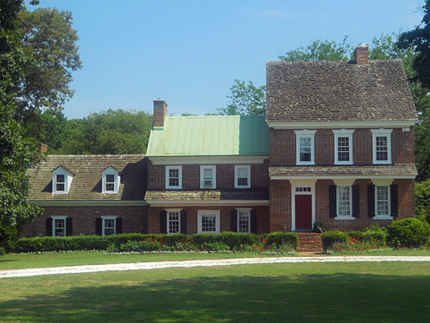
Holmeland
410 Fort Elfsborg Rd.
Map / Directions to Holmeland
Map / Directions to all Revolutionary War Sites in the town of Salem
This house is a private residence.
Please respect the privacy and property of the owners.
The oldest part of this house was built circa 1729. In 1762, the house and surrounding property were purchased by Benjamin Holme. Holme went on to serve in the Revolutionary War as Colonel of the South Jersey Militia.
During the March 1778 occupation of Salem, Benjamin Holme was one of the seventeen Salem citizens who British Colonel Mawhood specifically threatened retribution against if the local militia did not stand down. [9]
The local militia did not stand down, and three days later, a British raiding party led by Colonel Mawhood set fire to this house, as well as to the barns and outbuildings.
Before burning the house, Mawhood had the valuable furnishings removed, including an elaborate 8'4" Wagstaff Clock which was taken to British General William Howe's headquarters in New York City. After the war, Holme reclaimed his clock, which is now exhibited at the Salem County Historical Society. (See next entry)
The insides of the house had been destroyed in the fire, but its walls remained standing, and so Holme rebuilt the inside of the house. In 1784, the tall wing of the house (seen in the right of the photo above) was added by Holme. [10]

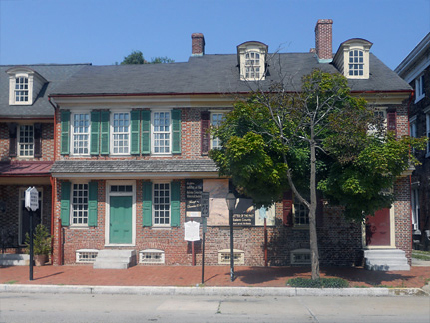
Salem County Historical Society
79-83 Market St.
Map / Directions to the Salem County Historical Society
Map / Directions to all Revolutionary War Sites in the town of Salem
For hours and admission information, see the
Salem County Historical Society Website
This building was originally a house built in 1721 by a prominent citizen of Salem named Alexander Grant. It is now used as a museum and library by the Salem County Historical Society. The museum has items in its collections from the Revolutionary War era, including Colonel Holme's clock described in the Holmeland entry above.
Behind the museum, there is a small brick building known as the John Jones Law Office that dates to circa 1736. Originally a law office, it was later used as an office by Dr. Ebenezer Howell, who served as a Major in the Revolutionary War. [11] Howell was one of seventeen Salem residents specifically threatened in the letter by British Colonel Mawhood during the Salem occupation.[12] His office building was then vandalized and partially burned by the British.
The small building originally stood near Broadway and Market St. It was moved to the garden behind the Alexander Grant House in 1967.[13] Another Salem property connected with Dr. Howell is shown in the next entry.

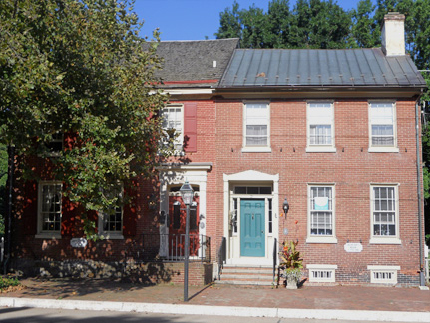
Jacob Hufty and John Wistar Houses
21 and 23 Market St.
Map / Directions to the John Wistar House
Map / Directions to all Revolutionary War Sites in Salem
This house is a private residence.
Please respect the privacy and property of the owners.
These two adjoining houses belonged to two of the seventeen militiamen who were specifically threatened by name by Colonel Mawhood during the March 1778 occupation of Salem.
The building on the left was originally the property of Dr. Ebenezer Howell, who served as an officer in the Salem County Militia, and whose office is described in the Salem County Historical Society entry above. It is believed that Dr. Howell built the rear section of the house circa 1790. The house is now known as the John Wistar house, after a later owner who purchased it in 1812 and added the front section in 1814. [14]
The house on the right was the home of blacksmith Jacob Hufty, who served as a militia private in the Revolutionary War. He was politically active after the war, serving in a number of local positions, including freeholder, county judge, sheriff and county collector. He served in the United States House of Representatives from 1809 until his death in 1814. He is buried at a tenth of a mile south of here at St. John's Episcopal Church. [15]

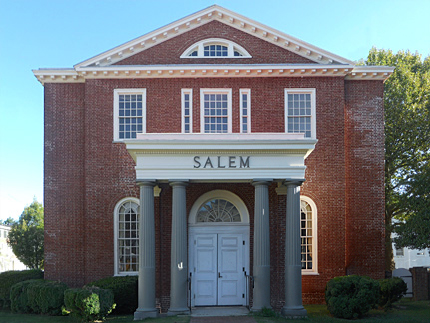
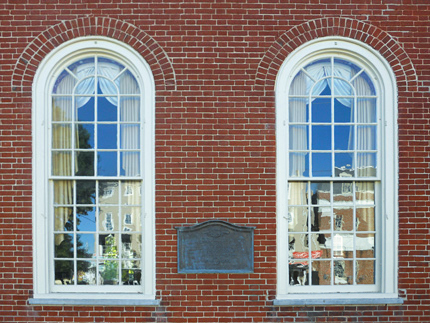
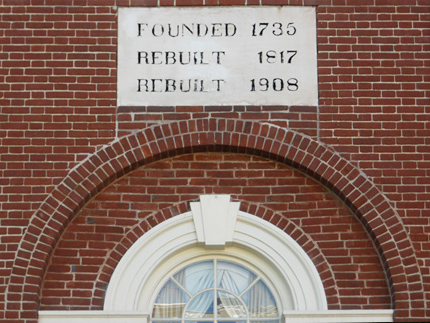
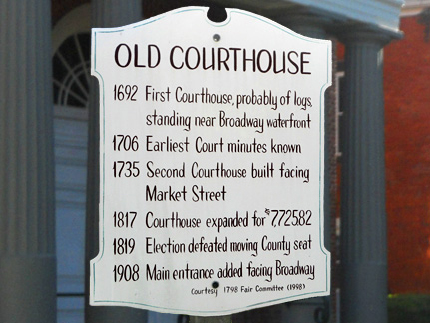
Old Salem County Courthouse
Market St. and E. Broadway
Map / Directions to the Salem County Courthouse
Map / Directions to all Revolutionary War Sites in the town of Salem
Parts of the Old Salem County Courthouse were built in 1735, making it New Jersey's oldest continuously operating courthouse. It is the second oldest in the country. King William County Courthouse in Virginia is the country's oldest.
The Courthouse's connections to the Revolutionary War began a year before the war actually started, when New Jersey was still a British colony. On December 16, 1773, the Boston Tea Party occurred in Boston, Massachusetts, when tons of British tea were dumped into Boston harbor in protest of British taxation. In retaliation, the British blockaded and occupied Boston. Shortly after, a resolution was passed at this courthouse to provide aid and relief to Boston and its citizens. In March 1775 the citizens of Salem County gave four hundred and twenty dollars that they had raised "to be forwarded to their suffering brethren in Boston." This is the equivalent of about $13,000 today.
After the March 1778 British occupation of Salem, a series of treason trials known as the "Long Court" was held here. On trial were local Tories suspected of having assisted the British during the occupation of Salem County. [16] Tories were Americans who remained loyal to the British in the Revolutionary War.

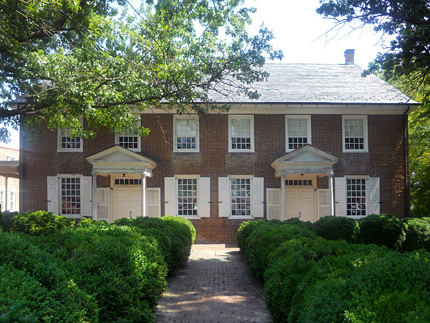
During the British occupation, some British troops encamped at the Salem Friends Meeting House, which was built in 1772.
After the end of the war, the meeting house was used to hold court to settle cases regarding the confiscation of property belonging to local Tories who had assisted the British during the occupation. [17]

1. ^ Information about the March 1778 occupation of Salem was drawn from several sources, including:
• John Graves Simcoe, Simcoe's Military Journal (New York: Bartlett & Welford, 1844) pages 46 - 54
Available to be read at Google Books here
▸ John Graves Simcoe served as a Major under Colonel Mawhood. Simcoe gives considerable detail about the military actions and manoeuvres of his troops. However, his account is written to downplay the harshness of the occupation. This is particularly noticeable in his account of the militiamen who were killed at Hancock House, where Simcoe does not mention that they were bayoneted in their sleep.• Robert Gibbon Johnson, An Historical Account of the First Settlement of Salem, in West Jersey (Philadelphia, Orrin Rogers, 1839) Pages 147 - 163
• Several contemporary newspapers mentions of the occupation of Salem can be found in:
Francis B. Lee, Editor Archives of the State of New Jersey, Second Series, Vol II (Documents Relating to the Revolutionary History of the State of New Jersey / Extracts from American Newspapers relating to New Jersey) (Trenton: John L. Murphy Publishing Company, 1903) Pages 129, 133, and 159
Available to be read at the Internet Archive here• For more information and accompanying source notes about the events at Quinton's Bridge and Hancock's Bridge during the Salem occupation, see the Quinton and Hancock's Bridge pages of this website.
2. ^ History page of the church's website, and the historic sign in front of the church
3. ^ The seventeen militiamen named in Colonel Mawhood March 21, 1778 letter to Colonel Hand were:
Edmund Keesby, Thomas Sinnickson, Samuel Dick, Whitten Crips, Ebenezer Howell, Edward Hall, John Bowen, Thomas Thomson, George Trenchard, Elisha Cattle, Andrew Sinnickson, Nicholas Keen, Jacob Hufty, Benjamin Holme [spelled Holmes in the letter], William Shute, Anthony Sharp, and Abner Penton
▸ The letter is reprinted in:
Francis B. Lee, Editor Archives of the State of New Jersey, Second Series, Vol II (Documents Relating to the Revolutionary History of the State of New Jersey / Extracts from American Newspapers relating to New Jersey) (Trenton: John L. Murphy Publishing Company, 1903) Page 168 - 169
Available to be read at the Internet Archive here4. ^ Biographical Dictionary of The United States Congress
5. ^ Biographical Dictionary of The United States Congress
The Biographical Dictionary entry states that Hufty's birth date was unknown. However, the modern gravestone that was placed in the cemetery for Hufty in 2014 states that he was born in 1750. A May 13, 2014 South Jersey Times article about the placing of Hufty's modern gravestone can be read at the NJ.com website here.6. ^ Military information for Colonel Andrew Sinnickson from:
William S. Stryker, Official Register of the Officers and Men of New Jersey in the Revolutionary War (Trenton: Wm. T. Nicholson & Co., 1872) pages 376 and 410
Available to be read at Google Books hereThe Constitution of Sons of the Revolution, and By-laws and Register of the Society in the State of New Jersey (Trenton, 1913) Page 95
Available to be read at Google Books here7. ^ Biographical Dictionary of The United States Congress
8. ^ Name and date information from their gravestones in the cemetery, which are marked with Revolutionary War Veteran plaques.
9. ^ Colonel Mawhood letter to Colonel Hand, March 21, 1778
Reprinted in:
Francis B. Lee, Editor Archives of the State of New Jersey, Second Series, Vol II (Documents Relating to the Revolutionary History of the State of New Jersey / Extracts from American Newspapers relating to New Jersey) (Trenton: John L. Murphy Publishing Company, 1903) Page 168
Available to be read at the Internet Archive here
10. ^ Information about the house and the Wagstaff Clock was drawn from the Salem County Historical Society brochure for Open House in Fenwick's Colony - Salem County, New Jersey Saturday, May 5, 2012 - Pages 4 and 27. Available as a PDF on the Salem County Historical Society website here.
11. ^ The Constitution of Sons of the Revolution, and By-laws and Register of the Society in the State of New Jersey (Trenton, 1913) Page 95
Shows the following information for Ebenezer Howell:
"Major of Colonel Silas Newcomb's Battalion, General Heard's Brigade, New Jersey Militia, June 22d, 1776; Major of the Fourth Battalion, Second Establishment, New Jersey Line, November 28th, 1776. Proscribed by name in proclamation of Colonel Mawhood, British Commander, March 21st, 1778""
Available to be read at Google Books here12. ^ Colonel Mawhood letter to Colonel Hand, March 21, 1778
Reprinted in:
Francis B. Lee, Editor Archives of the State of New Jersey, Second Series, Vol II (Documents Relating to the Revolutionary History of the State of New Jersey / Extracts from American Newspapers relating to New Jersey) (Trenton: John L. Murphy Publishing Company, 1903) Page 168
Available to be read at the Internet Archive here13. ^ Information about the John Jones law office was drawn from the Salem County Historical Society brochure for Open House in Fenwick's Colony - Salem County, New Jersey Saturday, May 5, 2012, and the historic sign next to the building
14. ^ Salem County Historical Society brochure for Open House in Fenwick's Colony - Salem County, New Jersey Saturday, May 5, 2012 - Page 10 Available as a PDF here.
15. ^ Biographical Dictionary of The United States Congress
16. ^ Information about the Salem County Courthouse was drawn mainly from:
Salem County Historical Society brochure for Open House in Fenwick's Colony - Salem County, New Jersey Saturday, May 5, 2012 - Page 8 and 10 Available as a PDF here.• The "to be forwarded to their suffering brethren in Boston" quote was drawn from a short article which appeared in the Pennsylvania Gazette, No. 2415, April 5, 1775.
The full article read:
"PHILADELPHIA, April 5. - Last week the Committee of Salem county, in New- Jersey, paid into the hands of the Chairman of this Committee of this city, Four Hundred and Twenty Dollars, to be forwarded to their suffering brethren in Boston."
It is reprinted in:
A. Van Doren Honeyman, Editor, Documents Relating to the Colonial, Revolutionary and Post-Revolutionary History of the State of New Jersey, First Series - Volume XXXI (Somerville NJ, Unionist-Gazette Association, 1923) page 102
Available to be read at the Internet Archive here
• For more information about King William County Courthouse in Virginia, see:
~ National Register of Historic Places / Inventory - Nomination Form for King William County Courthouse
Available as a PDF here
~ Historic American Buildings Survey documents for King William County Courthouse
Available as a PDF at the Library of Congress website here17. ^ Salem County Historical Society brochure for Open House in Fenwick's Colony - Salem County, New Jersey Saturday, May 5, 2012 - Page 7. Available as a PDF here.